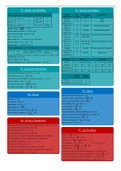Other
Sheet of All A-level Physics Equations
This is a document of all of the equations, constants, and other important number related information points. The equations are organised neatly in their corresponding topic headings and colour coded for the sections they are in. Each equation has its units next to it and an arrow beside the equati...
[Show more]



